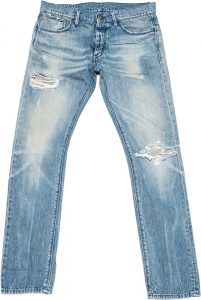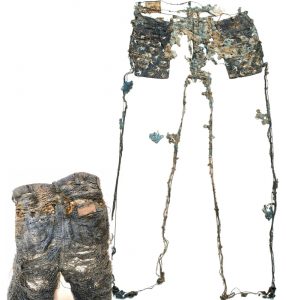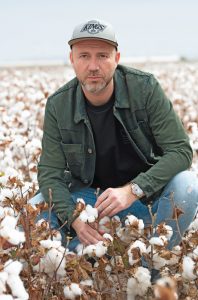
Lab tests showed Candiani’s new Coreva stretch denim is completely biodegradable.
By Antonia Wilson
“We buried the jeans in March and they were gone in January,” CEO Alberto Candiani said of Candiani Denim’s most recent experiment.
Ten months sounds impressive, but controlled lab tests have shown the Italy-based brand’s new stretch denim, Coreva, can almost completely biodegrade in as little as six months in optimum conditions. “We tried to compost Coreva stretch jeans in our backyard and it worked,” Candiani said. “The difference between the lab test and our backyard test is that temperature and humidity are not constant in nature.” This of course means consumers could try the experiment for themselves, years down the line in their own compost bins.
Natural Rubber Component
First launched in 2020, Coreva replaces the need for petrochemical-based elastane often found in stretch denim and stretch fabrics more widely. Made using organic cotton yarns wrapped around a natural rubber core yarn — both renewable sources — the resulting fabric is plastic-free meaning it also won’t shed microplastics when washed. However, the fabric still maintains the elasticity, durability and softness expected from high-quality stretch denim. Not only does this make it fully biodegradable — able to be broken down through composting — but also more easily processed post-consumer use, with fibers separated for reuse or recycling, in part thanks to the thickness of the rubber yarn.
“At the end of life of a product it would be correct first to upcycle it, then to downcycle it and at the end to recycle it,” Candiani explained. “When you recycle a product, an old pair of jeans for example, you will be able to extract a portion of material that can be reused to spin a new yarn to make a new jeans, but the rest will inevitably be waste. Our aim is to allow that waste to return to nature with a positive impact, giving purpose to the raw materials initially extracted to make the jeans as they can now be used to grow new raw materials.”
Given that the majority of clothing globally is now made from synthetic fabrics, Candiani’s innovation has overcome a major technological challenge that could have a huge impact on the fashion industry more widely.
Circular Product
The images from the experiment speak for themselves — a dusty outline of what was once that familiar pair of jeans, with only disjointed seams and disintegrated pockets remaining. It’s a stark, but refreshing sight compared to the images saturating the media showing diggers emptying fabric waste into landfills.
The aim is to create regenerative denim goods that can be returned to the environment — to use jeans to eventually grow the cotton to make jeans. The tangible circularity of Coreva comes at a time when the need to embrace nature-based solutions in fashion and recognize biodiversity as part of the climate crisis more widely, is more urgent than ever before. While many brands talk the talk in their sustainability strategies, critics say it often remains a check-box exercise, rather than brands legitimately addressing their impacts.
Consumers are increasingly savvy, demanding transparency, traceability and tangible efforts from brands to do better; and organizations including the United Nations continue to highlight the impact of the fashion industry, not only in terms of the environmental and ethical of production, but also post-consumer waste.
“Everything I’m doing is to connect the industrial and the agricultural systems in order to neutralize impacts and, if possible, to create a final positive impact of products on the environment through regenerative properties and practices,” Candiani said. “True design means problem-solving, and fashion has to look into circularity, science and smart materials in order to engineer products — starting with solutions to the problems those same products may create at the end of their lifecycle. Ethically, this should be mandatory, but we all know that the fashion industry is still massively over-producing without caring much — the reason why we need legislation and politics to regulate the industry.”

Candiani’s Coreva jeans almost completely
biodegrade in as little
as six months in
optimum conditions.
Fully Tested
Candiani has produced an impressive selection of sustainable fabrics, with a variety of certifications, but Coreva is an industry first and was trialed in collaboration with several partners including the Rodale Institute, a non-profit organization that supports regenerative agricultural research. “Rodale was, for us, the perfect partner to test Coreva’s regenerative circularity models and systems in every specific environment where organic and regenerative agriculture take place,” Candiani noted. “The idea was to test, verify and scientifically certify effectively on and in the ground Coreva’s compostability and regenerative properties.”
Experiments on the material’s biodegradability, disintegration and ecotoxicity — a measure of a substance’s harm to animals and plants — were carried out to determine compostability, in compliance with European Union standards. However, since there is not yet a dedicated certification process for compostable fabric, the closest available category of packaging was selected. All of the criteria were met, and after 12 weeks, 98.1 percent of Coreva’s original mass had disintegrated. Mung beans and barley were grown to test soil health and conditioning capacity, with results showing significantly better growth of up to 23.5 percent. More recently, growing Candiani’s hybrid, non-GMO cotton variety, Blue seed cotton — designed to produce a stronger fiber, be more resistant in the field, and require less water and chemicals — also was successfully tested.
Although Candiani does not claim to have invented stretch denim, the brand is known to be an expert in the industry. Perfecting Coreva for production still took five years of research and development, however, refining the biogen fabric to ensure it was hard-wearing in consumer use, but biodegradable post-use. “A big challenge was the original vulcanization process of that rubber which was not allowing the elastic to be fully biodegradable, but we fixed that thanks to a very solid partner that tweaked the process and gave us a yarn which is not only bio-based but also biodegradable — and compostable,” Candiani said. The final challenge was about its performance and stability, he noted. But that was an “easy fix” — perhaps unsurprising given the brand’s heritage as a leader in its field.

Company Ethos
As a fourth-generation denim producer, Candiani is taking strides to innovate both the family company and the industry, and his vision to uphold heritage while embracing change follows his globally minded father. Candiani talks about sustainability as a mission based on location rather than a journey. In operation since 1938, the company’s mill in the town of Robecchetto con Induno, Italy, sits between Milan and the Alps. Since 1974, it has been located at the heart of a nature reserve called Parco Del Ticino, running alongside the River Ticino, with a hugely diverse ecosystem. Despite being Europe’s largest denim mill, with two plants covering 85,000 square meters of production, it has been dubbed the “greenest mill in the blue world” with much stricter local environmental regulations than other denim mills, Candiani reported, which the brand has fully embraced.
“No other large textile operation in the world is located inside a nature reserve,” Candiani said. “The national reserve was founded decades after the mill was originally started so we found ourselves all of a sudden surrounded by it. Being immersed inside such a delicate environment that required special attention and care made us think and act differently in terms of production and productivity, challenging us to come up with our own best practices in order to reduce our impact on nature.”
The brand has now developed a full Coreva collection, including shirts and pants in various fits and colors. British designer Stella McCartney and Dutch jeansmakers Denham are among the first brands beyond Candiani to use Coreva in their own collections. Candiani acknowledges that it may not be a swift transition across the entire industry, given that Coreva can cost 30- to 50-percent more than conventional man-made stretch denim. He remains confident, however, as Coreva outperforms synthetics in terms of elasticity, recovery and comfort, according to Candiani. The aim is to have all Candiani stretch denim made with Coreva by 2030. Alongside this, the brand will use regeneratively grown cotton in at least 50 percent of the entire production of its denim by next year.
Given the growing body of research showing the devastating pace of biodiversity loss and its link with climate change, a move towards regenerative agriculture is something more brands need to engage with. Regenerative agriculture involves a holistic, natural approach to farming, prioritizing long-term value over short-term gain. For instance, practices such as crop rotation, natural grazing patterns, avoiding chemical pesticides and planting native trees or creating wetlands to boost biodiversity. This approach not only reverses soil erosion, which helps ecosystems become more resilient against droughts, desertification and wildfires, but it can also improve the health of the soil, which allows it to absorb a greater amount of carbon from the atmosphere. And sequestering carbon, particularly through soil, is, arguably, the biggest nature-based solution to climate change. It’s not only a means to future-proof the land, but future-proof a business as well.
Candiani will no doubt continue to disrupt, innovate and reinvent — but, what could the future of fashion look like in a dream world of circularity? “Edible fabrics,” Candiani noted. “I can’t promise you yet that in the future we’ll be able to eat our jeans at the end of their lifecycle instead of throwing them away. What I can tell you for sure, is that we have already made it possible to link industrial denim production to regenerative agriculture by creating edibles, such as veggies, using old jeans as soil conditioner.”
Editor’s Note: Antonia Wilson is a freelance writer and editor.
November/December 2022




